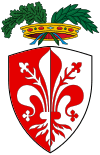Scandicci
| Scandicci | |
|---|---|
| Comune | |
| Comune di Scandicci | |
 The old town hall of Scandicci | |
 Scandicci Location of Scandicci in Italy | |
| Coordinates: 43°45′N 11°10′E / 43.750°N 11.167°E | |
| Country | Italy |
| Region | Tuscany |
| Metropolitan city | Florence (FI) |
| Frazioni | Badia a Settimo, Capannuccia, Casellina, Granatieri, Le Bagnese, l'Olmo, Mosciano, Pieve a Settimo, Rinaldi, San Colombano, San Martino alla Palma, San Michele a Torri, San Vincenzo a Torri, Santa Maria a Marciola, Scandicci Alto, Vingone, Viottolone |
| Government | |
| • Mayor | Sandro Fallani (Democratic Party) |
| Area | |
| • Total | 59.6 km2 (23.0 sq mi) |
| Elevation | 47 m (154 ft) |
| Population (30 November 2014)[1] | |
| • Total | 50,517 |
| • Density | 850/km2 (2,200/sq mi) |
| Demonym(s) | Scandiccesi |
| Time zone | UTC+1 (CET) |
| • Summer (DST) | UTC+2 (CEST) |
| Postal code | 50018 |
| Dialing code | 055 |
| Patron saint | St. Zenobius |
| Saint day | May 10 |
| Website | Official website |

Pieve of Sant'Alessandro a Giogoli.
Scandicci (Italian pronunciation: [skanˈdittʃi]) is a comune (municipality) of c. 50,000 inhabitants in the Metropolitan City of Florence in the Italian region Tuscany, located about 6 kilometres (4 miles) southwest of Florence.
Scandicci borders the following municipalities: Campi Bisenzio, Florence, Impruneta, Lastra a Signa, Montespertoli, San Casciano in Val di Pesa, Signa.
The settlement of Scandicci appeared in 1774 as Torri, and was later enlarged to incorporate several neighbouring communities.
Main sights
Scandicci's main attraction is the Villa i Collazzi, a Mannerist building whose design is attributed to Michelangelo. Other sights include:
- badia of San Giuliano a Settimo, known from 774.
- Pieve di Sant'Alessandro a Giogoli, in the neighbourhood. Known from 1035, it is in Romanesque style and has a nave with two aisles (the latter, together with the transept, decorated in Baroque style). In the rectory is a fresco by Ridolfo del Ghirlandaio and a canvas by Francesco Conti.
- Pieve di San Vincenzo
- Church of San Martino alla Palma, with a 16th-century portico. The interior, on a single nave, houses a 14th-century Madonna with Child Enthroned.
- Church of Sant'Andrea, at Mosciano, with some 13th-14th century paintings.
Nearby is also the Badia a Settimo.
Twin cities
Notable people
References
External links
| Wikimedia Commons has media related to Scandicci. |
This article is issued from
Wikipedia.
The text is licensed under Creative Commons - Attribution - Sharealike.
Additional terms may apply for the media files.
